The Complete Guide to Types of e-Learning for Trainers
Curious about the different types of e-learning and how they impact training? Discover the main formats, their benefits, and which one fits your learners best.
Curious about the different types of e-learning and how they impact training? Discover the main formats, their benefits, and which one fits your learners best.

Over 90% of companies now offer some form of eLearning to their employees. This surge is a strategic move to enhance workforce skills, increase productivity, and stay competitive in the market.
However, with various types of e-learning formats available, selecting the right one can be a daunting task. Using the wrong format can disengage learners, waste resources, and hinder the achievement of company goals.
To avoid this situation, trainers and L&D professionals need to understand the different types of e-learning and when to use each. We’ll help you achieve this by breaking down the most common e-learning formats, their benefits, and how to align them with your organization’s training objectives.
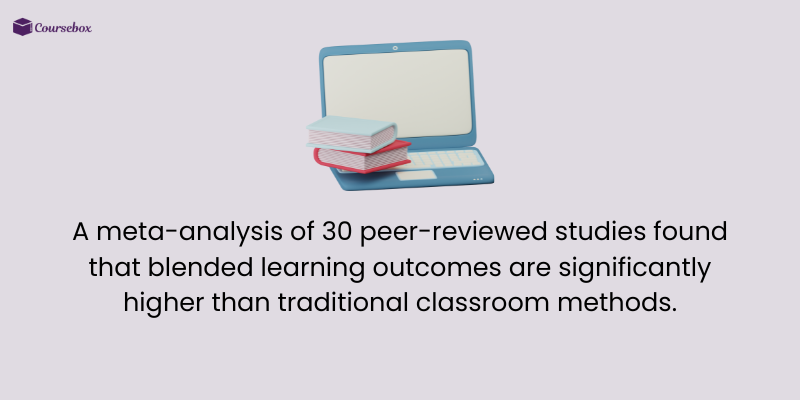
You’d be surprised to know how engaging training can be when you combine multiple e-learning types like videos, simulations, and more.
In fact, a meta-analysis of 30 peer-reviewed studies found that blended learning outcomes are significantly higher than traditional classroom methods. It’s because each first fills a different gap.
For instance, videos simplify concepts, simulations build confidence, and discussions reinforce understanding. Together, they create a learning loop that keeps people engaged and accountable.
In simple terms, using various types of e-learning makes learning more practical. It turns passive viewers into active participants and transforms training from a one-time event into a lasting experience.
What if training doesn’t feel like a chore to the employees? That’s exactly what happens when you find the right format.
However, as there are multiple types, you cannot use all of them. To make the choice easier, here are ten of the most common types of e-learning you can choose from:


Microlearning is about keeping things concise, straightforward, and easy to recall. Rather than sitting through hour-long lessons, learners get information in bite-sized formats, such as quick videos, flashcards, or short quizzes.
This format fits modern attention spans and is ideal for busy professionals who need to learn without losing productivity.
Research from the Journal of Applied Psychology found that microlearning increases the transfer of learning by 17%. That’s a massive advantage for you, especially when you’re aiming for real results.
For companies, microlearning is easy and cost-effective. With it, you can break down lengthy training manuals into concise modules, each focused on a single key takeaway. Short bursts of learning keep employees engaged and motivated.
Interactive video learning transforms the passive act of watching into an active learning experience. With this, your employees can click, respond, and explore within the video itself.
It might involve choosing how a scenario unfolds, answering a question midway, or exploring a visual hotspot for extra details. This hands-on engagement keeps learners actively involved and creates a stronger emotional connection with the content.
The results speak for themselves as well. Studies found that interactive videos increased learner engagement by 66%. That shows why this format works like a charm in any corporate setting.
When people actively interact with what they’re watching, they absorb more information and feel more confident applying it in real-world situations. This gives learners control, and when learners feel in control, they stay engaged.
Mobile learning, or m-learning, puts knowledge right in the pocket. It allows learners to access training anywhere, on a phone, tablet, or laptop, without being tied to a desk. For employees who are constantly on the move, it’s one of the most practical approaches to continuous education.
The best part is its adaptability. Content can range from quick micro-lessons to interactive quizzes, making it easy to fit into short breaks or commutes.
Moreover, with over 68% of corporate learners preferring mobile learning, it’s one of the best types of e-learning that you can add to your existing training programs. This gives your employees a chance to learn at their own pace.
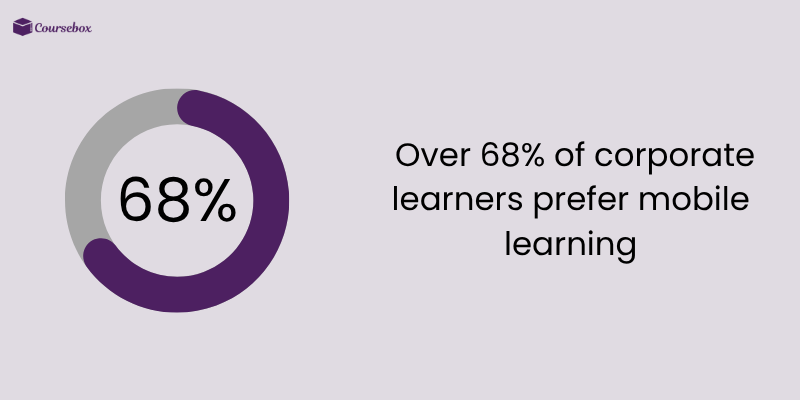
Gamification turns learning into an experience that feels less like studying and more like playing. It uses elements such as points, leaderboards, badges, and challenges to spark motivation. When learners see progress, they’re more likely to stay engaged and push themselves further.
But this isn’t about fun; it’s about results.
Companies that gamify their learning see higher completion rates, deeper engagement, and better knowledge retention. Games trigger the release of dopamine, which makes learning feel naturally satisfying.
To implement it, you can gamify compliance courses, onboarding programs, or skill development modules. Simple actions, such as unlocking badges for milestones or adding quizzes that mimic real-world challenges, can make your training modules much more engaging.
This next type of e-learning puts learners in realistic situations where they must think, decide, and act. Instead of memorizing facts, they apply their knowledge to solve problems, just as they would in a work setting.
Scenario-based learning has been shown to increase knowledge retention by up to 75% because it directly connects theory to real-world applications. Learners remember better when they see how concepts play out in practice.
You can use scenario-based modules for leadership training, customer service simulations, or safety practices. By recreating real-life challenges in a safe digital environment, employees learn to manage pressure and make more informed decisions.
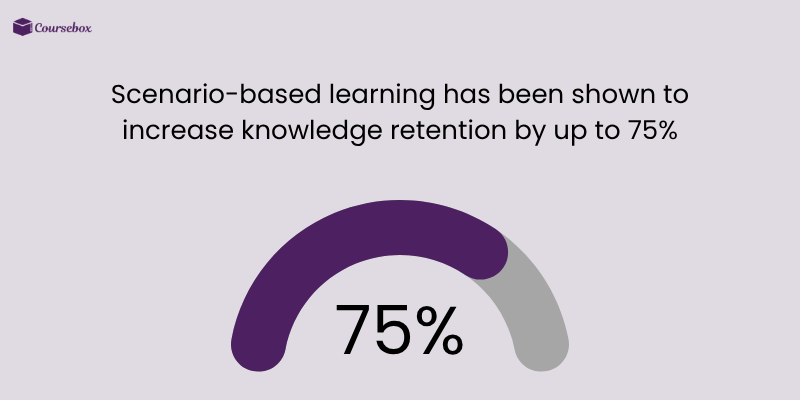
Compliance training may not sound exciting, but it’s one of the most essential types of e-learning for any organization.
It makes sure that employees understand and follow regulations, safety rules, and company policies, which help avoid legal risks and maintain workplace integrity. However, when done traditionally, it can feel dull.
That’s why modern e-learning platforms now make compliance engaging through micro-lessons, gamification, and interactive modules.
Research shows that companies that utilize e-learning to enhance compliance training experience a completion rate of up to 60%. It’s mainly because employees engage better when training is interactive and concise.
Organizations can make compliance more useful by breaking down content into relatable scenarios and incorporating short quizzes.
Blended learning combines the best of both worlds, online and in-person training. It allows learners to absorb theory through digital modules and apply it through workshops, discussions, or mentoring sessions.
This balance caters to different learning preferences and keeps the process dynamic. It’s simply because the learners get a variety of learning modules, which helps them apply what they learn in their business.
Businesses can adopt blended learning by pairing self-paced online lessons with instructor-led sessions or live group discussions. It’s especially useful for leadership or technical programs where collaboration enhances learning and development.
Simulation-based training immerses learners in realistic, controlled environments where they can practice skills without real-world risks. Think of pilots using flight simulators or doctors rehearsing surgeries in virtual labs.
It’s all about learning through hands-on experience.
The method has been proven to build confidence and enhance skill retention. Although there are few examples in corporate training, the Biological and Clinical Sciences Research Journal supports this type of training.
Studies have found that simulation-based learning improves procedural accuracy by up to 88%. This makes it one of the most effective ways to teach complex or high-stakes tasks. Simulations can be created for customer interactions, machinery operation, or crisis response.
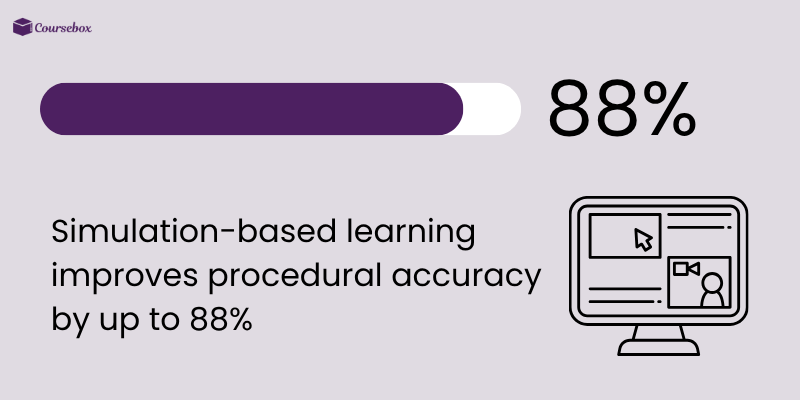
Social learning thrives on interaction. It’s based on the idea that people learn best when they exchange ideas, share experiences, and observe others. This type of e-learning brings collaboration into the digital space through discussion boards, peer feedback, and live group projects.
To understand how social learning works and how effective it is, TalentLMS conducted a survey. They found that 66% (one-third) of the surveyed employees believe that social learning would improve the efficiency of workplace training.
You can encourage social learning by creating internal knowledge hubs or mentorship communities where employees share the knowledge they’ve gained. When people teach and learn from each other, information spreads faster and morale improves.
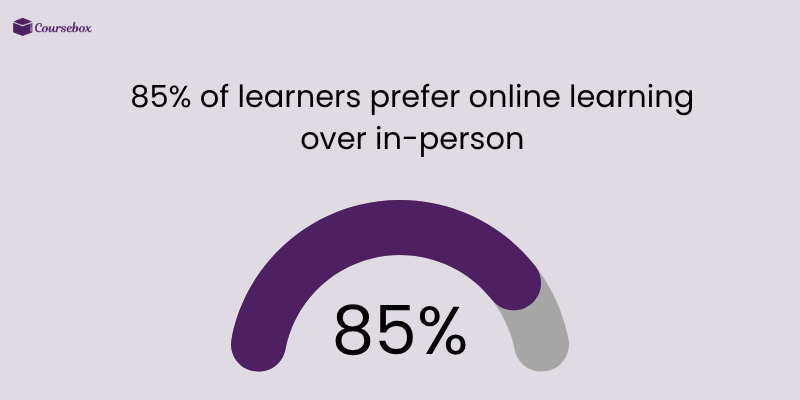
Instructor-led virtual training (ILVT) brings the structure of traditional classroom sessions into a digital setting. Studies also show that 85% of learners prefer online learning over in-person lectures, which makes ILVT a standout option for companies.
It combines real-time teaching with online convenience, allowing learners to interact with instructors, ask questions, and participate in discussions remotely. This method remains powerful because human connection still matters.
Moreover, ILVT is ideal for upskilling programs or technical training that benefits from expert guidance. Use platforms like Zoom or Microsoft Teams and integrate them with your LMS to implement ILVT in your organization.
However, if you’re wondering which LMS would be best for this, we’d suggest using Coursebox’s AI LMS. It lets you create training videos within minutes and also offers AI chatbots to answer any queries in real-time.
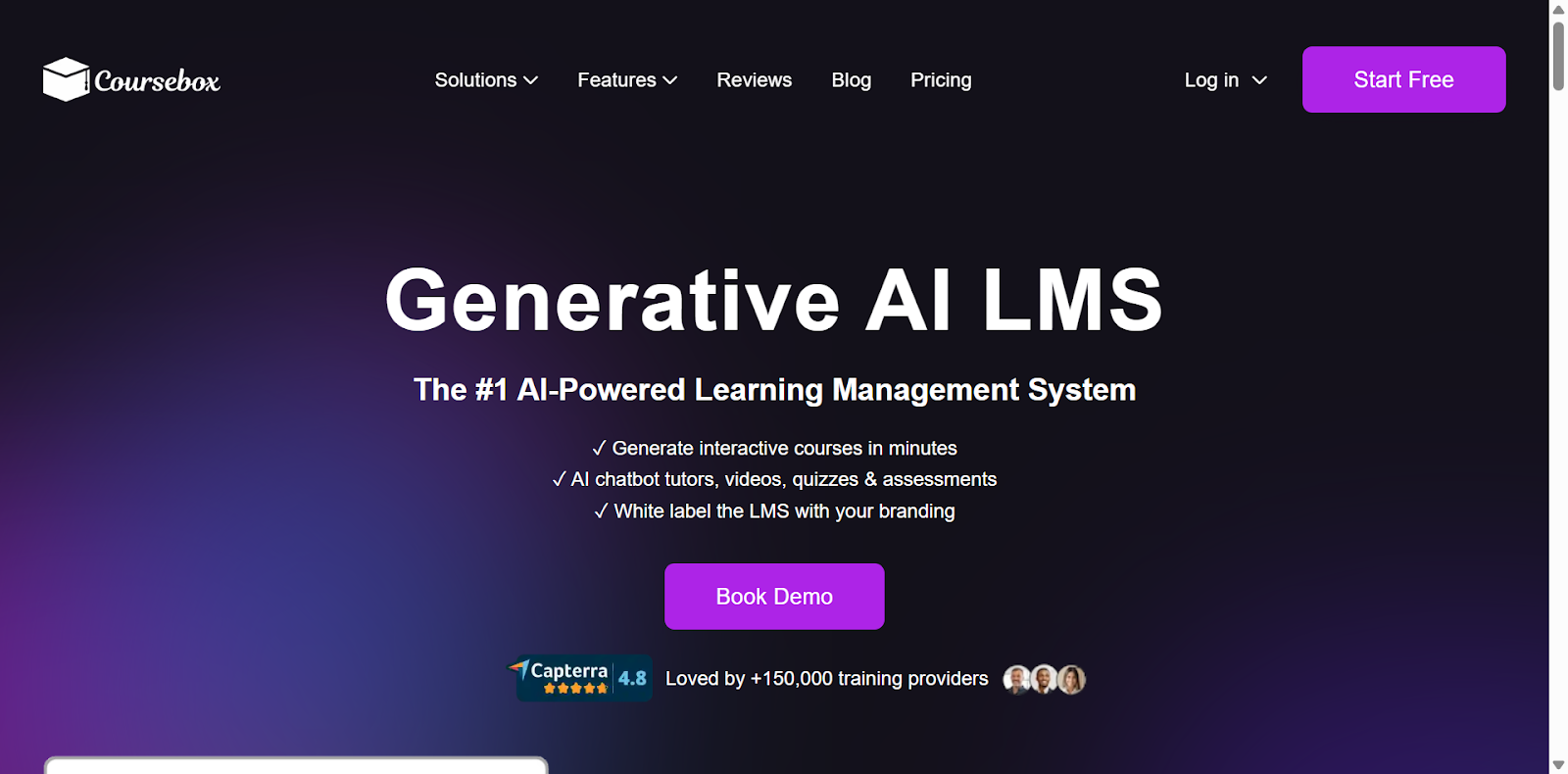
Alt text: Coursebox Generative AI LMS
Choosing the right e-learning format isn’t just about what looks good or feels new. It’s about matching the method to your learners, goals, and business outcomes. Here’s how to make that choice confidently.
Before exploring formats, ask: What do I want my employees to achieve?
If your goal is knowledge retention, microlearning or interactive videos should be your preferred e-learning type. Similarly, for behavior change or skill application, scenario-based or simulation learning is more effective. By choosing the right one, you’ll see your employees performing better.
Not all content fits every medium. Some examples you can keep in mind include:
A general rule of thumb you can follow is that the more hands-on the skill, the more immersive the learning type should be.
Your budget, time, and tools matter just as much as your goals. Creating simulations requires a higher investment, whereas microlearning or video lessons can be rolled out more quickly.
Lastly, if you want to save both time and cost, consider using tools like Coursebox, which can easily blend multiple formats.
Even though the different types of e-learning are crucial for building more adaptable training programs, they alone aren’t enough. You also need a platform that can help you combine the most relevant types into one for your employees.
The best part is you don’t need to look far, as Coursebox offers everything you need to make learning more engaging.
With AI-generated training videos, AI-powered LMS, and analytics that track learner progress, you can focus less on logistics and more on outcomes.
Sign up to Coursebox for free today and turn learning into an experience!
Interactive e-learning relies on a mix of tools that make learning engaging, hands-on, and accessible. The most common ones include LMS like Coursebox, which help organize, track, and deliver content. Tools like Coursebox are used to create interactive courses with quizzes, branching scenarios, and animations.
E-learning follows a clear progression that helps turn an idea into a complete learning experience. The four stages of e-learning are:
The 3 P’s represent the core foundation of every successful e-learning program:
Together, these three pillars help organizations create e-learning that’s organized, learner-focused, and scalable.
There’s no one-size-fits-all answer, but most learners engage best with modules that last 10 to 20 minutes. That’s long enough to explain a concept clearly without overwhelming attention spans. If your topic is complex, consider splitting it into shorter microlearning lessons that learners can complete at their own pace.
